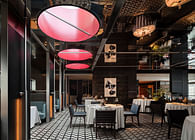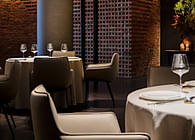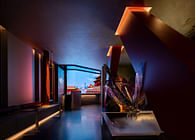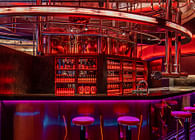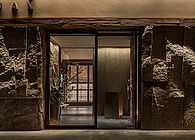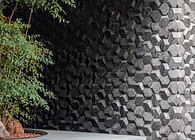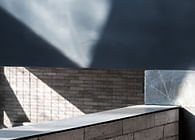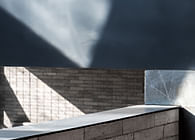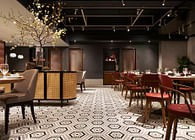
“As Siji Minfu Roast Duck Restaurant, which has sought expansion outside Beijing, is assuming more responsibilities of endorsing the city, the interior designer Wu Wei has magnified the Beijing culture embedded in its brand genes to facilitate the acquisition of new customers and improvement of brand influence.”
At the beginning of 2022, the fifteen-year-old brand Siji Minfu originated in Beijing eventually launched its maiden expansion outside the city and opened a new outlet on the Wusong road of the Bund Shanghai. Upon opening, the restaurant has become a much-visited place and generated despite an average waiting time of two or three hours not a single compliant on the social media, but rather numerous positive reviews that “the delicious food is worth all the wait”.
The space design is by Wu Wei, designer from Beijing IN•X Design Company, who has once again created a catering space for Siji Minfu that will result in distinctive memories—through powerful and recognizable brand genes tinted with splendid and solemn Beijing culture.
01
Desire for the Nature under City Confinement
If the space design of restaurants under Siji Minfu in Beijing tended to express the brand genes in a restrained way, the design of the first restaurant in Shanghai undoubtedly adopted an explicit strategy, with the roofs, bricks, pine trees, and red pillars delivering the grandeur and elegance. When customers rest their eyes on the landscape of the remains of the Great Wall in the main dining area, which is desolate while arresting, they would realize time froze at the moment and the historical scenes are seemingly presented in the most luxurious building of Shanghai.
For the restaurant, the best design that matches the modernity of Shanghai will not be achieved through the urban scenes as what has been practiced in Beijing, but rather through a grand atmosphere and the representation of the hustle and bustle of the daily life—reminiscent of the days when the relatives of imperial officials walked past the walls of the Forbidden City, ordinary citizens talked and walked through the brick porches; the autumn wind blew over the Great Wall and the Yan Mountains in the north; and the grass and wood grew in abundance over the years…With effortless maneuvers, the designer Wu Wei has managed to reveal the vibes and spirit of the restaurant once and for all, endowing the new space with irreplaceable charm.
02
A Combination of Tradition and Modernity in the Space
The internal space of the restaurant that spans 1,180 square meters was designed to be in an irregular shape of the letter “D”. The private dining rooms and the chef’s kitchen were arranged along the straight wall, the equipment room and the warehouse in the corner on the right, and the main dining area and view area along the parabola-like wall, of which the glass wall added to the loveliness and liveliness of the space by enabling customers to enjoy outdoor views in the well-lit area.
Walking from the waiting area to the landscape of a Beijing-style porch featuring grey bricks and tiles, customers will arrive at the main entrance, where an open cellar with glass walls on three sides and a dimly lit U-shaped bar counter on the left and right side respectively create two contrasting atmospheres. The landscape of old brick walls coupled with the use of modern materials such as metal and acrylic interprets the vibes of the space in a perfect way.
The landscape of the Great Wall in the background is outlined against the lights at the bar counter. In the major open area, the space of high ceilings is dominated by the color of green and grey, and a large landscape composed of the city wall and plants divides the area beside the window into two parts while leaving openings for customers to walk around, making the main dining area separated into different areas a feast for the eyes on its own.
In the north of the main entrance, the arrangement of booths and round tables emphasizes a sense of order, the red pillars become the highlight of the plain-colored space, the metal nets separate tables from tables without completely blocking the view so as to visually create a sense of ceremony, the bricks and stones echo the broken walls, and the well-lit cellar lit up the innermost part of the space. On the other side of the space, the original and antique wood walls naturally form another function area.
At the north end of the space, the entire wall made of rough bricks is connected with the ceiling. Three curved wall structures are designed to separate the VIP rooms from booths in the main dining area, and arranged in a way that each of the structures seems rotating clockwise to open the doors to the VIP rooms for customers, through which the art of architecture in the entire internal space is expressed to the fullest. Both the smell of food and the cultural landscapes become secondary, which gives room for the expressiveness of the “grand background” characterized by roughness and substance.
03
Priority Given to Business Strategy Over Interior Design
As a leading brand of Beijing cuisine, Siji Minfu has been well-stablished in the industry in the city of Beijing. With brand genes sealed in the brand itself and the heart of local customers, the restaurants in the city can only win more competitive edge by innovation when it comes to space design. However, as a new entrant in Shanghai, the brand needs to make a debut of genuine and distinctive Beijing characteristics to bolster its popularity.
Consequently, the designer Wu Wei has summarized and amplified the Beijing culture embedded in the brand genes to position the style of space design for the first restaurant of Siji Minfu in Shanghai, which facilitated the acquisition of customers and improved the brand influence. The strategic catering space design advocated by IN•X Design has helped establish the awareness and stickiness of brands among customers through constantly updated spaces, thus propelling the transformation and upgrade of brands.
Status: Built
Location: Shanghai, CN
Firm Role: Interior Design
Additional Credits: Lead Designer: Wu Wei
Design Team: Jia Qifeng, Jia Chenjuan, Liu Chenyang
Interior Decoration: Jin Shengxu, Ying Zheguang, Song Jiangli
Photography: Zheng Yan
Project Planning: Le Brand Strategy Agency
Copywriting Agency: NARJEELING



